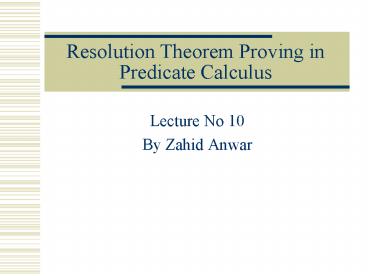Resolution Theorem Proving in Predicate Calculus - PowerPoint PPT Presentation
1 / 14
Title:
Resolution Theorem Proving in Predicate Calculus
Description:
Is Ali happy? Another Example. Anyone passing the AI Exam and winning ... Add negation of the conclusion happy(ali) pass(X,AI) V win(X,lottery) V happy(X) ... – PowerPoint PPT presentation
Number of Views:169
Avg rating:3.0/5.0
Title: Resolution Theorem Proving in Predicate Calculus
1
Resolution Theorem Proving in Predicate Calculus
- Lecture No 10
- By Zahid Anwar
2
Resolution
- Resolution is a technique for proving theorems in
predicate calculus - Resolution is a sound inference rule that, when
used to produce a refutation, is also complete - In an important practical application resolution
theorem proving particularly the resolution
refutation system, has made the current
generation of Prolog interpreters possible
3
Resolution Refutation
- The resolution principle, describes a way of
finding contradictions in a data base of clauses
with minimum substitution - Resolution Refutation proves a theorem by
negating the statement to be proved and adding
the negated goal to the set of axioms that are
known or have been assumed to be true - It then uses the resolution rule of inference to
show that this leads to a contradiction
4
Resolution Refutation
- Once the theorem prover shows that the negated
goal is inconsistent with the given set of
axioms, it follows that the original goal must be
consistent . - This proves the theorem
5
Steps in Resolution Refutation Proofs
- Put the premises or axioms into clause form
- Add the negations of what is to be proved in
clause form, to the set of axioms - Resolve these clauses together, producing new
clauses that logically follow from them - Produce a contradiction by generating the empty
clause - The substitutions used to produce the empty
clause are those under which the opposite of the
negated goal is true
6
Discussion about Steps
- Resolution Refutation proofs require that the
axioms and the negation of the goal be placed in
a normal form called the clause form - Clausal form represents the logical database as a
set of disjunctions of literals - Resolution is applied to two clauses when one
contains a literal and the other its negation
7
Discussion about Steps
- If these literals contain variables, they must be
unified to make them equivalent - A new clause is then produced consisting of the
disjunction of all the predicates in the two
clauses minus the literal and its negative
instance (which are said to have been resolved
away)
8
An Example
- We wish to prove that
- Fido will die from the statements that
- Fido is a dog and
- all dogs are animals and
- all animals will die
9
Equivalent Reasoning by Resolution
- Convert these predicates to clause form
Predicate Form Clause Form
x dog(x)?animal(x) dog(x) V animal(x)
Dog(fido) Dog(fido)
yanimal(y) ?die(y) animal(y) V die(y)
10
Apply Resolution
- Negate the conclusion that fido will die
die(fido) - dog(x) V animal(x) animal(y) V die(y)
- Y/X
- dog(fido) dog(y) V die(y)
- fido/Y
- die(fido) die(fido)
- a Null clause?Hence fido will die
11
Another Example
- Anyone passing the Artificial Intelligence exam
and winning the lottery is happy. But anyone who
studies or is lucky can pass all their exams. Ali
did not study be he is lucky. Anyone who is lucky
wins the lottery. Is Ali happy?
12
Another Example
- Anyone passing the AI Exam and winning the
lottery is happy - Xpass(x,AI) ? win(x, lottery) ?happy(x)
- Anyone who studies or is lucky can pass all their
exams - X Y studies(x) V lucky(x) ?pass(x,y)
- Ali did not study but he is lucky
- study(ali) ? lucky(ali)
- Anyone who is lucky wins the lottery
- X lucky(x) ?win(x,lottery)
13
Change to clause Form
- pass(X,AI) V win(X,lottery) V happy(X)
- study(Y) V pass(Y,Z)
- lucky(W) V pass(W,V)
- study(ali)
- Lucky(ali)
- lucky(u) V win(u,lottery)
- Add negation of the conclusion happy(ali)
14
- pass(X,AI) V win(X,lottery) V happy(X)
- win(u,lottery) V lucky(u)
- u/v
- pass(u,AI) V happy(u) V lucky(u)
- ali/u happy(ali)
- pass(ali,AI) V lucky(ali)
- lucky(ali)
- pass(ali,AI)
- Ali/v,AI/w lucky(v) V pass(V,W)
- lucky(ali) lucky(ali)































